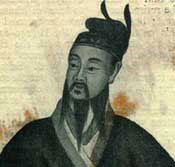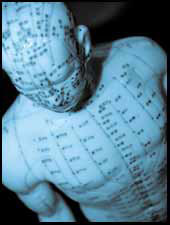Where did it all begin?
The acupuncture healing system practiced today was formalized, documented and passed down by the Chinese, who are known to have practiced it as early as 2000 B.C. In the ongoing debate about the ancient discipline's genesis, this fact is undisputed. But acupuncture's timeline predates paper (which, coincidentally, was discovered by the Chinese in the second century B.C.), and this makes it difficult to accurately pinpoint its true beginning.
Among the ancient discipline's earliest artifacts are stone needles found in inner Mongolia, dating back to about 3000 B.C. Oral tradition holds that these were not inserted into the skin, but rather pressed against it by Stone Age physicians who understood that they could prompt a healing response in the body by stimulating certain points. Other early artifacts include drawings, dating from around 1600 B.C., of acupuncture needles made of such materials as bamboo, fish bone, and bronze.
Today, acupuncture needles are made from stainless steel and measure a mere one-hundredth of an inch in diameter. But while the tools of the trade have changed, modern day practitioners still rely on and adhere to the principles set forth in The Yellow Emperor's Classic of Medicine (also known as the Nei Jing). The oldest and best known text on acupuncture and traditional Chinese medicine, this Taoist classic was written as a discourse between the Yellow Emperor (Huang Di) and his ministers. It is believed to have been completed somewhere between the second and first century B.C., and is viewed as the highest authority on traditional Chinese medicine. Although some claim that the legendary Yellow Emperor discovered acupuncture, history suggests that a system of medicine like the one documented in his famous canon was already well developed and widely used prior to his reign.
The spread of acupuncture
Experts revisited acupuncture's timeline in 1991, when “Otzi,” a well-preserved Ice Age Mummy was discovered in the Alps. Otzi had a series of seemingly non-ornamental tattoos located along a combination of acupuncture points that would have held strong therapeutic significance for his medical problems. (Forensic x-rays showed that, when he was alive, Otzi had joint, intestinal and spinal issues.) This led scientists involved in the study to conclude that an early form of acupuncture may have been used in Eurasia some 2,000 years earlier than originally believed.
The form of acupuncture documented in The Yellow Emperor's Classic of Medicine and practiced world wide today first spread to Korea, Vietnam and Japan, probably by around 562 A.D, and then across Europe in the late 1800s. It likely accompanied Chinese immigrants to the United States at around the same time, but its use here stayed mainly within the borders of urban Chinatowns. With few exceptions, members the American medical establishment viewed acupuncture as quackery, and that stigma endured for over a century. In fact, as recently as 1974, a Chinese-born acupuncturist named Dr. Miriam Lee was arrested in San Francisco for practicing medicine without a license.
How the West was won: Miriam Lee, acupuncture pioneer
Upon settling in California in the 1960s, Dr. Lee gave up her acupuncture practice and began working in a factory. Moved by the plight of a friend’s bed-ridden child, she offered her acupuncture services. When the child recovered, news traveled via word of mouth, and Lee was inundated with patients requesting treatment. They lined up at court to testify on her behalf following her arrest, and days later California Governor Ronald Reagan legalized acupuncture as an experimental procedure. In 1976, Governor Jerry Brown signed legislation legalizing it as an accepted medical practice in California, and Lee became one of the state's first licensed acupuncturists. She ran the Acupuncture Association of America from its inception in 1980 until 1998, it is said that at the height of her practice, she worked 80-hour weeks, seeing up to 10 patients an hour.
Foreign relations shine spotlight on acupuncture
Acupuncture was actually introduced to America's mainstream consciousness a few years prior to its legalization in California. While on assignment in China covering a Nixon administration visit, New York Times correspondent, James Reston needed an emergency appendectomy and received acupuncture for post-operative pain. He wrote an article about his experience for the Times in July 1971.
Studies show acupuncture works
One of the oldest, most commonly used medical procedures in the world, acupuncture remains an evolving science, and new treatment applications continue to emerge. The World Health Organization lists over 40 common disorders that respond to acupuncture treatment, The Centers for Disease Control and Prevention (CDC) acknowledges the benefits of acupuncture in the treatment of Chronic Fatigue Syndrome, and the National Cancer Institute says it can be effective for controlling pain and chemotherapy side effects.
Acupuncture in America
Most American medical schools now offer courses on complementary medicine. Many healthcare insurance providers cover acupuncture in their plans, and more may follow suit, as a bill requiring them to do so is currently being considered in the Legislature. The 2002 National Health Interview Survey found that approximately 8.2 million U.S. adults have received acupuncture treatment. Current estimates put the number of nationally certified acupuncturists practicing in the United States at 15,000, and there are some 50 colleges of acupuncture and oriental medicine in this country accommodating more than 7,000 students.


